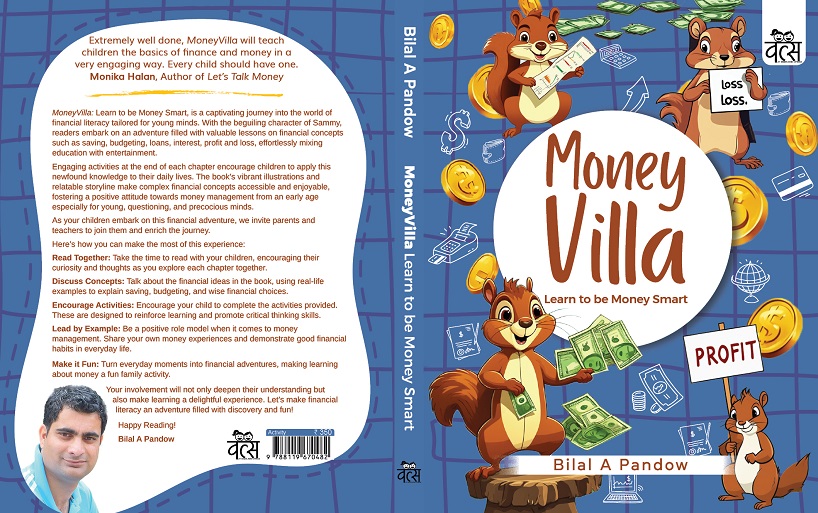
By Nimra Jeelani
Financial literacy is one of the most important life skills in today’s world. With social media flooded with finance jargons urging people to make smart investment choices, a lot of people find themselves completely clueless. This is because school curricula have rarely ever focused on imparting skills like knowledge about managing finances.
Making informed financial decisions is essential and empowers people to navigate the complexities of the financial world with confidence and security. Young minds are our future and instilling financial literacy in such minds is very much the need of the hour.
Bilal A Pandow’s book “MoneyVilla: Learn to be Money Smart” is a step in this direction. Dr Bilal Ahmad Pandow is an author and educator with twenty years of experience in the field of finance His book gives young minds an opportunity to develop financial know-how and literacy very early in life.
Q1) Why did you feel that it was important to write a book like MoneyVillat?
I felt it was important to write “MoneyVilla: Learn to be Money Smart” because financial literacy is an essential life skill that is often overlooked in traditional education. Children and young adults are rarely taught how to manage money effectively, yet these skills are crucial for their future success. Through “MoneyVilla,” I wanted to create an engaging and accessible way for young readers to understand the basics of money management, such as saving, budgeting, and investing. The goal is to empower the next generation with the knowledge they need to make informed financial decisions and build a secure future.
Q2) Why did you choose to focus on financial literacy for young minds?
I chose to focus on financial literacy for young minds because the earlier we start teaching children about money, the better equipped they will be to handle financial responsibilities as they grow older. Financial habits are often formed early in life, and by instilling smart money management skills at a young age, we can help children develop a strong foundation for their future. Moreover, with the increasing complexity of financial systems and the influence of consumer culture, it’s more important than ever for young people to understand how money works. By focusing on young minds, “MoneyVilla” aims to prepare them for the challenges and opportunities they will face, enabling them to make sound financial decisions throughout their lives.
Q3) How did you come up with the character of Sammy and the storyline?
The character of Sammy and the storyline in “MoneyVilla” were inspired by a desire to create a relatable and engaging way to teach financial concepts to children. I wanted to avoid the traditional, often dry approach to financial education and instead craft a narrative that would capture the imagination of young readers.
Sammy was designed to be a character that children could see themselves in—curious, adventurous, and eager to learn. The storyline follows Sammy’s journey through different financial challenges and opportunities, allowing readers to learn alongside him in a fun and interactive way. Each chapter introduces a new lesson in financial literacy, presented through Sammy’s experiences, which makes the learning process feel natural and engaging.
In creating Sammy and the storyline, I drew on common financial situations that children might encounter or hear about in their own lives, such as saving for a goal, understanding the value of money, or making spending choices. By weaving these concepts into Sammy’s adventures, I aimed to make financial literacy accessible, enjoyable, and memorable for young readers.
Q4) What are some real-life examples or activities you recommend to reinforce the book’s concepts?
To reinforce the concepts in “MoneyVilla,” I recommend several real-life activities that parents and educators can use to make financial literacy more practical and engaging for children. For example, create a savings goal: Encourage children to set a small savings goal, such as saving for a toy or a special outing. Help them track their progress using a chart or a piggy bank, just like Sammy does in the book. This activity teaches the value of saving and delayed gratification. Also, budgeting practice: Give children a small weekly or monthly allowance and guide them in creating a simple budget. They can allocate portions of their money for saving, spending, and perhaps even donating. This exercise reinforces the concepts of budgeting and money management introduced in the book. By integrating these real-life examples and activities, children can apply the lessons from “MoneyVilla” in practical ways, deepening their understanding and helping them develop healthy financial habits that will benefit them for a lifetime.
Q5) How do you suggest addressing any challenges children might face when learning about money management?
When teaching children about money management, it’s important to recognize that they might face challenges such as difficulty grasping abstract concepts, staying motivated, or managing their emotions around money.
I have broken down complicated financial ideas into simple, age-appropriate terms. Used analogies, stories, or visuals to make abstract concepts like interest, budgeting, or investment more concrete and relatable. For instance, comparing saving money to planting seeds that grow into trees can help children understand the idea of saving and earning interest.
Also, I have tried to keep the learning process enjoyable by using games, interactive activities, and real-life scenarios. For example, you can turn budgeting into a game where children allocate “money” to different needs and wants, rewarding them for making wise choices. The more fun and engaging the process is, the more likely with patience, creativity, and support, you can help children develop a strong understanding of money management and build lifelong financial skills.
Q6) How do you see the role of financial education evolving in the future, especially for young audiences?
The role of financial education is poised to become even more critical in the future, especially for young audiences, as the financial landscape continues to evolve with advancements in technology and changing economic dynamics. By leveraging technology, emphasizing digital literacy, and integrating financial education into everyday learning, we can better prepare young audiences to manage their finances effectively and make informed decisions in an increasingly complex financial environment.
Q7) How did you decide which financial concepts to include in the book?
Deciding which financial concepts to include in “MoneyVilla: Learn to be Money Smart” involved a careful consideration of the fundamental skills that children need to build a strong financial foundation. The goal was to cover essential topics that would be both relevant and accessible to young readers. Here’s how I approached the selection process:
I started by identifying the core financial concepts that are crucial for anyone, regardless of age, to understand. This included saving, budgeting, spending wisely, and the basics of earning money. These are the building blocks of financial literacy and provide a foundation upon which more complex ideas can be introduced later.
Since the book is aimed at young minds, it was important to tailor the content to their cognitive level and interests. I focused on concepts that could be explained in simple, relatable terms and avoided topics that might be too abstract or complex for the target age group. For example, while investment is an important financial concept, I introduced it in a very basic form, focusing on the idea of “growing money” through saving rather than delving into stocks or mutual funds.
In addition to current relevance, I considered the long-term usefulness of the concepts. The financial world is evolving, so I included topics like digital money and basic financial security, which will become increasingly important as children grow older. This ensures that the lessons they learn today will still be relevant as they navigate their financial futures.
By carefully selecting and integrating these financial concepts into the story, I aimed to create a book that is both informative and enjoyable, helping young readers develop the financial skills they need to succeed in the future.
Buy the book here (weblink).
Follow this link to join our WhatsApp group: Join Now
Be Part of Quality Journalism |
Quality journalism takes a lot of time, money and hard work to produce and despite all the hardships we still do it. Our reporters and editors are working overtime in Kashmir and beyond to cover what you care about, break big stories, and expose injustices that can change lives. Today more people are reading Kashmir Observer than ever, but only a handful are paying while advertising revenues are falling fast. |
| ACT NOW |
| MONTHLY | Rs 100 | |
| YEARLY | Rs 1000 | |
| LIFETIME | Rs 10000 | |










